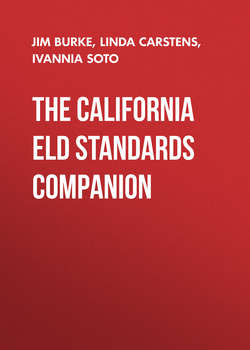Читать книгу The California ELD Standards Companion, Grades 3-5 - Jim Burke - Страница 8
На сайте Литреса книга снята с продажи.
ОглавлениеPrologue
To teachers of English language learners (and we are all teachers of English learners)
At this point in history, we are well poised in California to ensure language equity on behalf of English Language Learners (ELLs). Key leverage points and systems—including the CA ELD Standards, ELA/ELD Framework, the English Language Proficiency Assessments for California (ELPAC), the EL Roadmap, and Proposition 58—make this a pivotal time for ELLs to make measurable academic progress, in the manner that they have always deserved.
Figure 1 Leverage Points for Language Literacy (Soto, 2017)
The CA ELD Standards provide rigorous language expectations that our ELLs have needed to succeed in both language and across content areas. As educators, we have the gift of having the ELD standards align with the ELA standards, as well as the ELA/ELD Framework. We no longer need to learn a whole new set of standards that do not connect with our teaching throughout the school day. There is also no longer a disconnect between what is expected of native English speakers and ELLs. Instead, the two sets of standards—ELD and ELA—should work in tandem with each other. During Integrated ELD, content area standards are at the forefront, but we use the ELD standards to provide a language scaffold for that content. The focus, then, of Designated ELD should be language with the ELD standards at the forefront, but instruction should be connected to content instruction. That is, teachers are now free to do what we have known was best all along: connect language to content, so that language instruction is not disconnected from what happens throughout the rest of the school day.
Figure 2 ELD Working in Tandem (CDE, 2016)
The ELA/ELD Framework provides both the research base and practical examples via snapshots (individual lessons) and vignettes (units of study) of both Integrated and Designated ELD in action, as well as across grade levels and content areas. We have included key snapshots and vignettes that correspond to the standards being addressed throughout this companion series. The framework can assist us with making sure that we are appropriately integrating and teaching to the rigorous expectations of the ELD Standards.
The English Learner Proficiency Assessments for California (ELPAC) is aligned with the ELD Standards, and assesses listening, speaking, reading, and writing. Instead of assessing language out of context, this rigorous language assessment is also contextualized and embedded in content. For example, ELLs are no longer expected to listen to and retell a story about chocolate chip cookies, but instead must actively listen to an academic presentation and paraphrase key content. This suggests that we must know and teach the ELD Standards deeply, in order for ELLs to be successful with this new assessment.
The California English Learner Roadmap State Board of Education Policy: Educational Programs and Services for English Learners was passed by the State Board of Education on July 12, 2017. This policy is intended to provide guidance to local educational agencies (LEAs) in order to welcome, understand, and educate the diverse population of students who are English learners attending California public schools (CDE, 2017). There are four principles, which undergird this new policy, which include:
Principle One: Assets-Oriented and Needs Responsive Schools
Principle Two: Intellectual Quality of Instruction and Meaningful Access
Principle Three: System Conditions that Support Effectiveness
Principle Four: Alignment and Articulation Within and Across Systems
The vision and mission of the EL Roadmap, according to the California Department of Education website, are as follows, and further provide direction for educational systems regarding how to create equitable educational environments for ELLs.
Vision
English Language Learners fully and meaningfully access and participate in a 21st century education from early childhood through Grade 12 that results in their attaining high levels of English proficiency, mastery of grade-level standards, and opportunities to develop proficiency in multiple languages.
Mission
California schools affirm, welcome, and respond to a diverse range of English Language Learner (ELL) strengths, needs, and identities. California schools prepare graduates with the linguistic, academic, and social skills and competencies they require for college, career, and civic participation in a global, diverse, and multilingual world, thus ensuring a thriving future for California (CDE, 2017).
Lastly, Proposition 58 does away with strict English only policies in California. In the fall of 2016, Proposition 58, the California state ballot that created more opportunities for bilingual education, passed with overwhelming public support, at 73.5 percent. The research base has proven that students who are able to speak, read, and write in two or more languages are able to participate in several different cultural and language worlds. Additionally, multilingual proficiency actually strengthens how the brain functions. Bilingualism is also associated with more cognitive flexibility and better problem-solving abilities. Children who are bilingual tend to also perform better on achievement tests (Californians Together, 2017). Under Proposition 58, ELLs (and native English speakers) in California will once again be honored for their primary languages, and have an opportunity to become bilingual and biliterate. ELLs in bilingual programs in California are also required and expected to master the ELD and ELA standards. As such, they are also required to have participated in Designated and Integrated ELD, so all teachers must know these standards well in order for student mastery to occur.
It is an exciting time to be a teacher of ELLs in California! Understanding and teaching to the ELD Standards is one way to contribute to language equity. The California ELD Standards Companion should and can be used as a resource to assist educators in understanding the standards deeply so that they can better instruct and prepare ELLs around these more rigorous expectations. We recommend that teachers focus in and study the standards at their grade level, perhaps as a department or grade-level team. Then, they can use this resource to design their own lessons or units of study.
